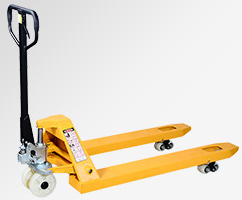News Details
Manual hydraulic forklift fork lifting operation
Manual hydraulic handling vehicles have become powerful tools in the field of logistics handling due to their easy operation and outstanding efficiency. The lifting and lowering of their forks mainly rely on hydraulic transmission systems, and the core structure includes key components such as manual pumps, oil cylinders, oil tanks, and control valves.
When it is necessary to lift the fork, the operator repeatedly presses the control lever of the manual pump. This action will push the piston inside the pump to compress the hydraulic oil, allowing the hydraulic oil to enter the cylinder through the oil pipe under pressure. As the volume of hydraulic oil in the cylinder continues to increase, the pressure gradually rises, pushing the piston rod of the cylinder to extend upwards, thereby driving the fork connected to the piston rod to rise steadily. During this process, the one-way valve plays a crucial role in effectively preventing hydraulic oil from flowing back, ensuring that the fork maintains a stable height when carrying cargo.

When it is necessary to lower the fork, the operator only needs to turn the handle of the control valve. This operation will open the return oil channel, and the hydraulic oil in the cylinder will flow back to the oil tank through the return oil channel under the action of the weight of the cargo and the weight of the piston rod itself. As the hydraulic oil in the cylinder decreases, the piston rod gradually retracts, and the fork will slowly descend. By adjusting the opening of the control valve, the descent speed of the fork can be precisely controlled to meet the operational needs in different scenarios.
This hydraulic transmission method not only makes the lifting operation of the fork effortless and convenient, but also achieves smooth operation, effectively ensuring the safety of goods during transportation, fully reflecting the significant advantages of manual hydraulic handling vehicles in improving work efficiency.

